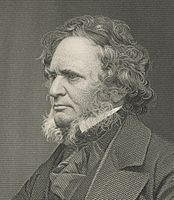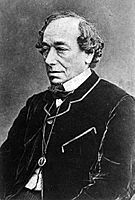Third Derby–Disraeli ministry facts for kids
Quick facts for kids Third Derby–Disraeli ministry |
|
|---|---|
  |
|
| Date formed | 28 June 1866 |
| Date dissolved | 1 December 1868 |
| People and organisations | |
| Monarch | Victoria |
| Prime Minister |
|
| Chancellor of the Exchequer | Benjamin Disraeli (1866–1868) |
| Total no. of members | 105 appointments |
| Member party | Conservative Party |
| Status in legislature |
Minority
dependent on Adullamite support |
| Opposition party | Liberal Party |
| Opposition leaders |
|
| History | |
| Outgoing election | 1868 general election |
| Legislature term(s) | 19th UK Parliament |
| Predecessor | Second Russell ministry |
| Successor | First Gladstone ministry |
This article is about the Conservative government that led the United Kingdom of Great Britain and Ireland from 1866 to 1868. This government was led by two important figures. Lord Derby was the Prime Minister and led the government in the House of Lords. Benjamin Disraeli was a key leader in the House of Commons.
History of the Government
Lord Derby Becomes Prime Minister
Lord Derby became Prime Minister for the third time in 1866. This happened after the previous Liberal government, led by Lord Russell, lost power.
Disraeli, who was the government's Chancellor of the Exchequer (the person in charge of the country's money), played a very important role. He helped pass a major law called the Second Reform Act in 1867. This law changed who was allowed to vote in the UK.
Disraeli Takes Over
After the new voting law was passed, it was clear that Disraeli would likely become the next leader of the Conservative Party. Even though some people in his party didn't fully support him, his success in getting the voting law passed made him very popular. He was especially praised for how well he debated against William Ewart Gladstone, a powerful leader from the Liberal Party.
The only question was about the health of Lord Derby, who was still the Prime Minister. Lord Derby's health had been getting worse for a while. In February 1868, he finally decided to step down. He advised Queen Victoria to ask Disraeli to become the new Prime Minister.
So, on February 27, 1868, Benjamin Disraeli became the Prime Minister of the United Kingdom. He famously said later, "I have climbed to the top of the greasy pole." However, the Conservative Party did not have the most seats in the House of Commons. Because of the new voting law, a new election had to be called. This meant Disraeli's time as Prime Minister would be short unless his party won the next election.
When Disraeli became Prime Minister, he made only a few changes to the government's top team, known as the Cabinet. He replaced Lord Chelmsford as Lord Chancellor (a top legal official) with Lord Cairns. Disraeli believed Cairns was a much stronger minister. He also chose the Earl of Malmesbury to lead the government in the House of Lords.
The Irish Church Issue
A big topic discussed in Parliament in 1868 was the "Irish Question." This mainly involved debates about the Anglican Church of Ireland. Many people felt that the Church of Ireland, which was the official church, should not be supported by the government in a country where most people were not Anglican.
The Government Ends
The Conservative government was defeated by the Liberal Party in the general election of 1868. After this loss, the new Liberal leader, William Ewart Gladstone, formed his first government.
Key Cabinet Members
The government had two main periods, first under Lord Derby, then under Benjamin Disraeli.
June 1866 – February 1868 (Derby's Cabinet)
This was the first part of the government, led by Lord Derby. Key roles included:
- The Earl of Derby as Prime Minister.
- Benjamin Disraeli as Chancellor of the Exchequer and leader in the House of Commons.
- The Lord Chelmsford as Lord Chancellor.
- Lord Stanley as Foreign Secretary.
Changes in Derby's Cabinet
In March 1867, three ministers, Lord Carnarvon, Lord Cranborne, and General Peel, resigned. They disagreed with the new voting law (the Reform Bill). They were replaced by the Duke of Buckingham, Sir Stafford Northcote, and Sir John Pakington. Three new members also joined the Cabinet: the Duke of Marlborough, the Duke of Richmond, and Henry Lowry-Corry.
In May 1867, Gathorne Hardy took over from Spencer Walpole as Home Secretary. Walpole remained in the Cabinet but without a specific department.
February 1868 – December 1868 (Disraeli's Cabinet)
This was the second part of the government, led by Benjamin Disraeli. Key roles included:
- Benjamin Disraeli as Prime Minister.
- The Lord Cairns as Lord Chancellor.
- George Ward Hunt as Chancellor of the Exchequer.
- The Earl of Malmesbury as Lord Privy Seal and leader in the House of Lords.
Changes in Disraeli's Cabinet
In September 1868, the Earl of Mayo left the Cabinet to become Viceroy of India. His replacement was not part of the Cabinet.
Images for kids


